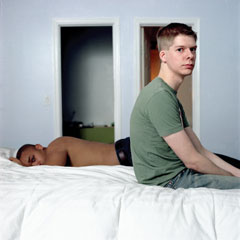Fringe Shorts: One An(d)other
Lightsey Darst calls the dense and evocative but frustrating One An(d)other by Jenny Pennaz Dance Works at the Red Eye promising.

In the all too cleverly titled One An(d)other, choreographer/director Jenny Pennaz flings a series of complicated, incredibly detailed vignettes at the audience, all—perhaps—building towards some larger theme. We’ll deal with the theme later, but first, the vignettes.
The show opens with Elliot Durko Lynch wobbling out on stage, playing noisily with a matchbox car. Behind him an image of a mechanic flares up on a projection screen. The photo, by Jason Hanasik, is of the detailed, true-to-life, brightly colored variety that seem so popular at the moment; but like the rest of Hanasik’s photos used in this show, this is a good example of the variety, and the way the image slowly moves, zooming in on the front corner of a threateningly racked, sickly green car, is especially effective. Besides the projection screen, a small television also shares the stage space; Lynch turns it on and watches some animation, running the car over his body and the TV, at one point sniffing the TV. When he leaves, Jenny Pennaz sets down, oh so carefully, two bandages, runs the car over her body, and tunes the TV in to some static; behind her on the projection screen a large woman stands in front of her vampy Chicago poster. And what’s that drumming in our ears—the sound of rain?
Reeling yet? Watching Pennaz’s vignettes, attempting to take in their variety and maniac specificity, is like sifting through a poet’s backlog of metaphors. Does Pennaz have any idea of the density of her work? Pennaz and her sister Amy Pennaz stand in their bathing suits, sometimes rising onto their toes; an image of themselves in the same suits, but thigh-deep in a lake, glows behind them. Here, the movement is as tight as if the dancers were bodybuilders. Strength? The image behind them becomes partly animated, the water moving while the women remain static. Shame? The bathing suits might be armor, or they might be painful self-revelation. Later, Emily Serafy Cox and Amanda Furches flop and lounge their way (Cox putting in an especially good sexpot impression) through a suggestive scene, mugging for a camera placed onstage. Then that’s over and some boxes get moved around. . . This work is so engaging, yet so confusing, that I’d like to apply the backhanded compliment promising to it: Pennaz can make a fiercely resonant moment like nobody’s business (her interaction with Hanasik’s photos is especially good), but she doesn’t expand her moments, doesn’t let the audience inside.
She also doesn’t link her vignettes, except by a theme so huge as to be useless—how we use our and other people’s bodies. Let’s see, it’s about shame, it’s about porn, posing, torture, murder, soldiers, marriage, an intimate relationship, and all in one hour. Some of these connections might work—how the whispered instructions of the sex film become the shouted commands of the military, for example—if they weren’t drowned in all the rest. Pennaz has too much here. She even has too many dancers. It’s not that any particular one should go (Lynch, Marciano Silva dos Santos, and Amy Pennaz were especially good), more that we don’t get to know any of them.
Still, too much is better (much better!) than too little. One of these days, maybe, Pennaz will produce something unified and complete. Until then, she’s done the next best thing—made it interesting.
n.b.*
On another note, it’s time to stop with the cute bios. You know, it’s nice that you grow bonsai or still like RC Cola or whatever, but sometimes I just want to know where you’re from and what you’ve done, you know? I get that the cute bios are meant to be friendly and humble, but they actually have the opposite effect: they’re insidery and off-putting. So, please, cease and desist.